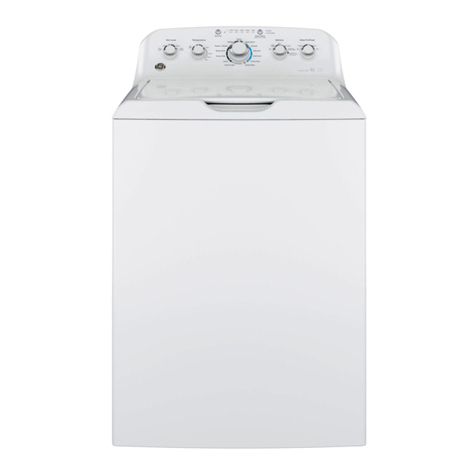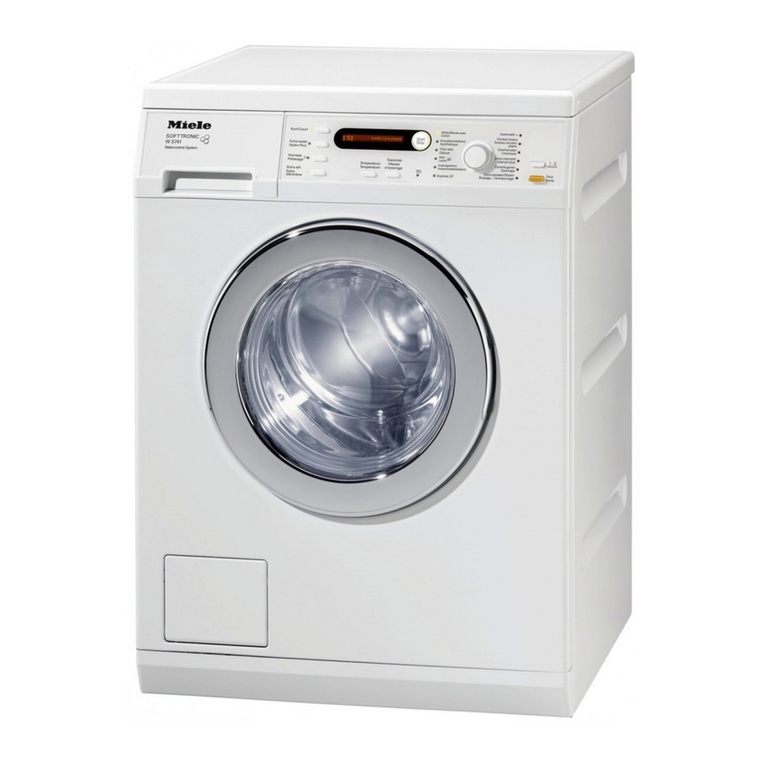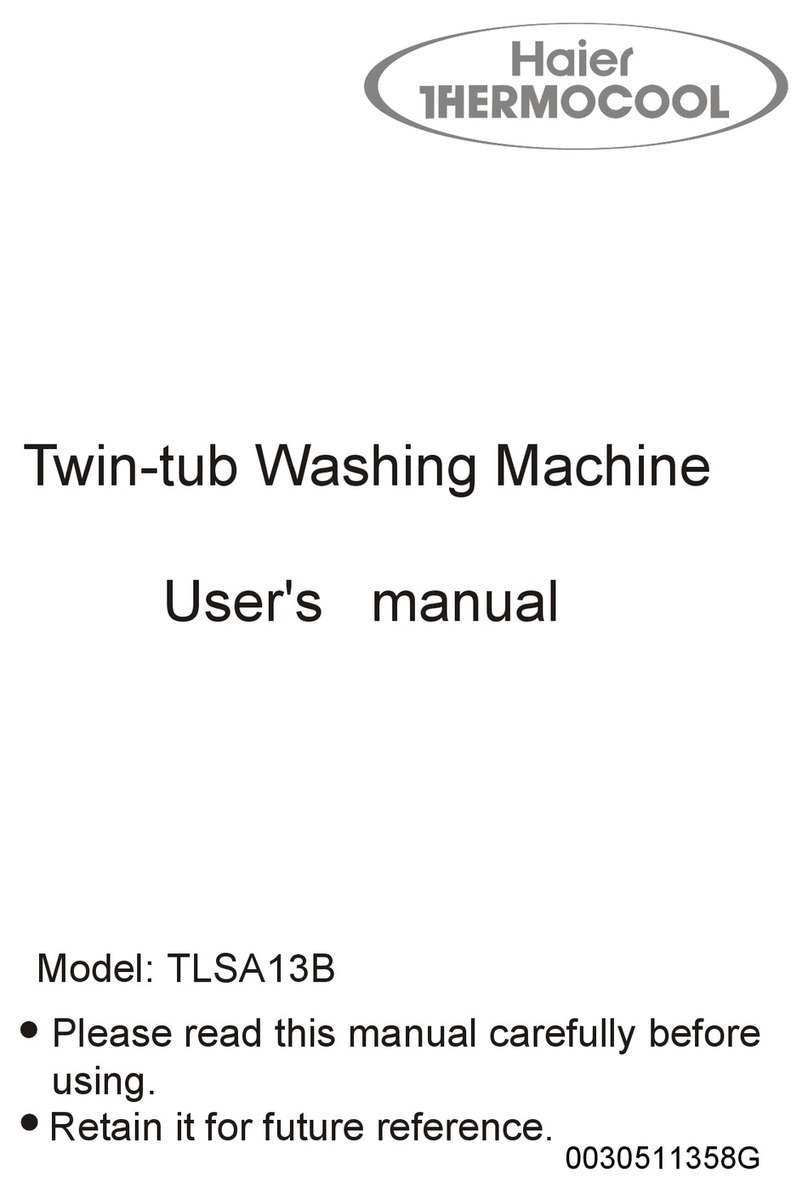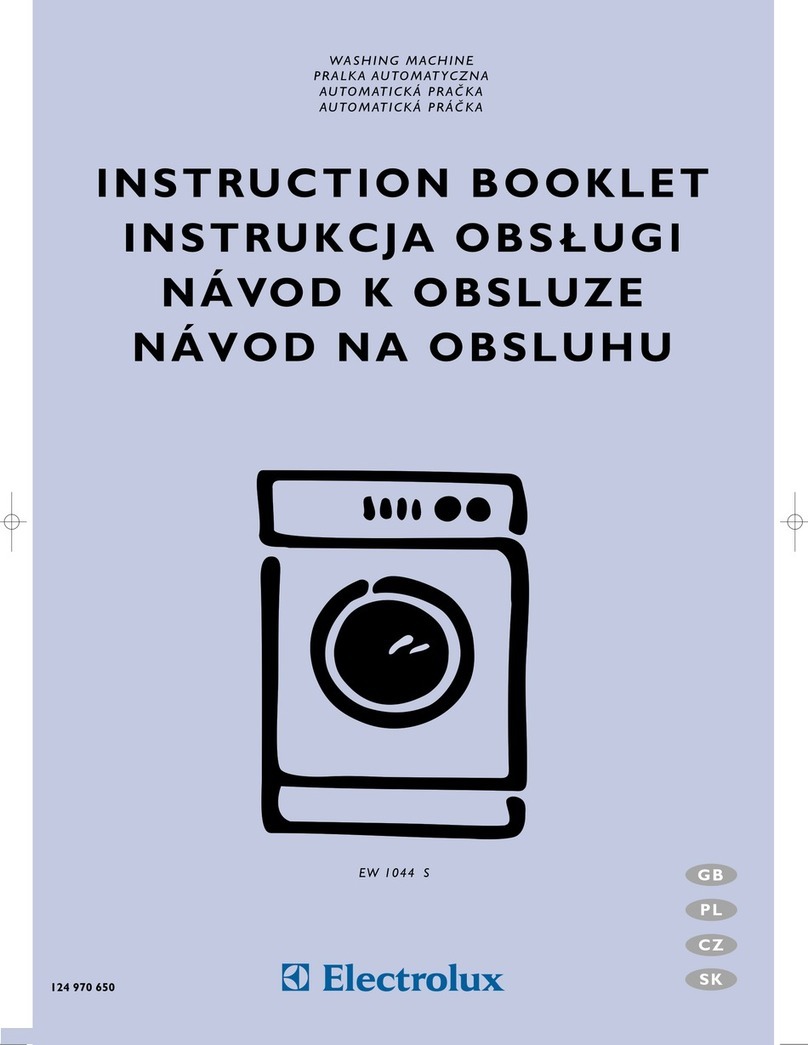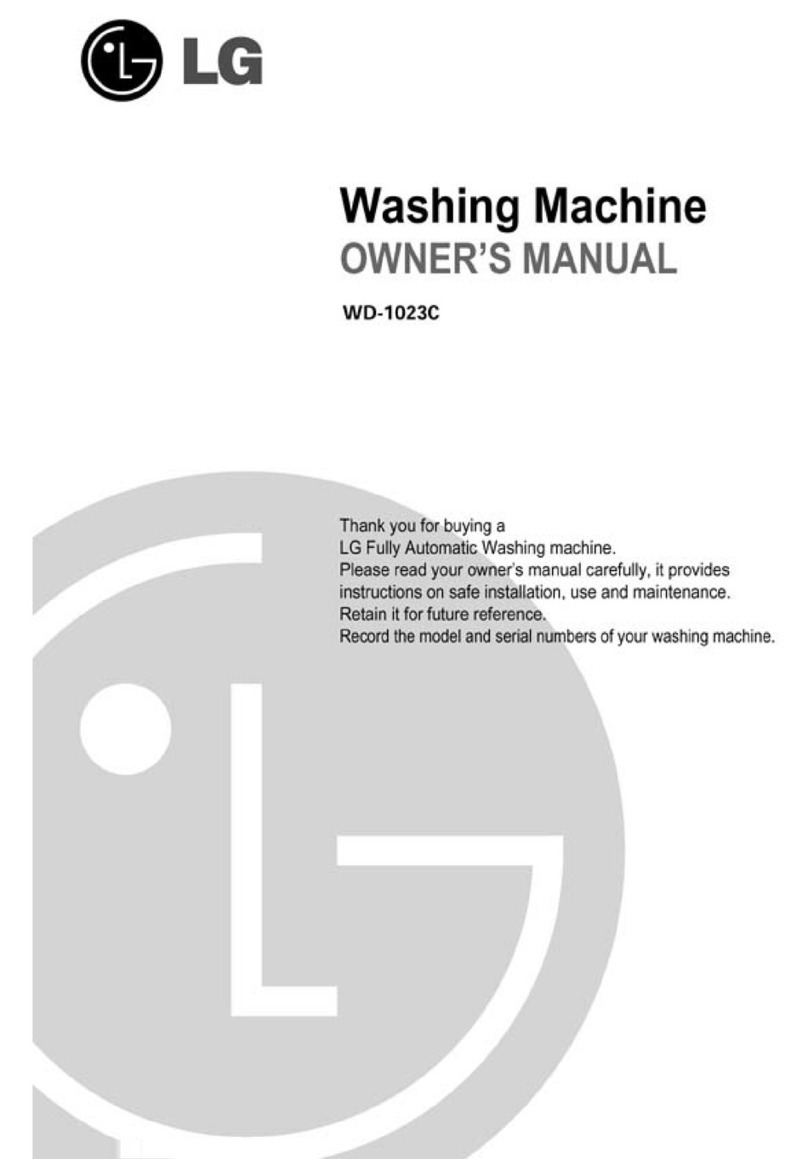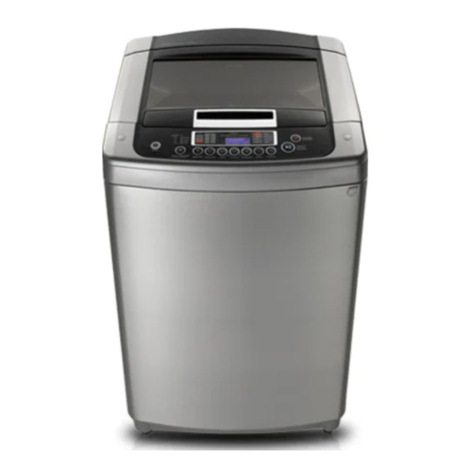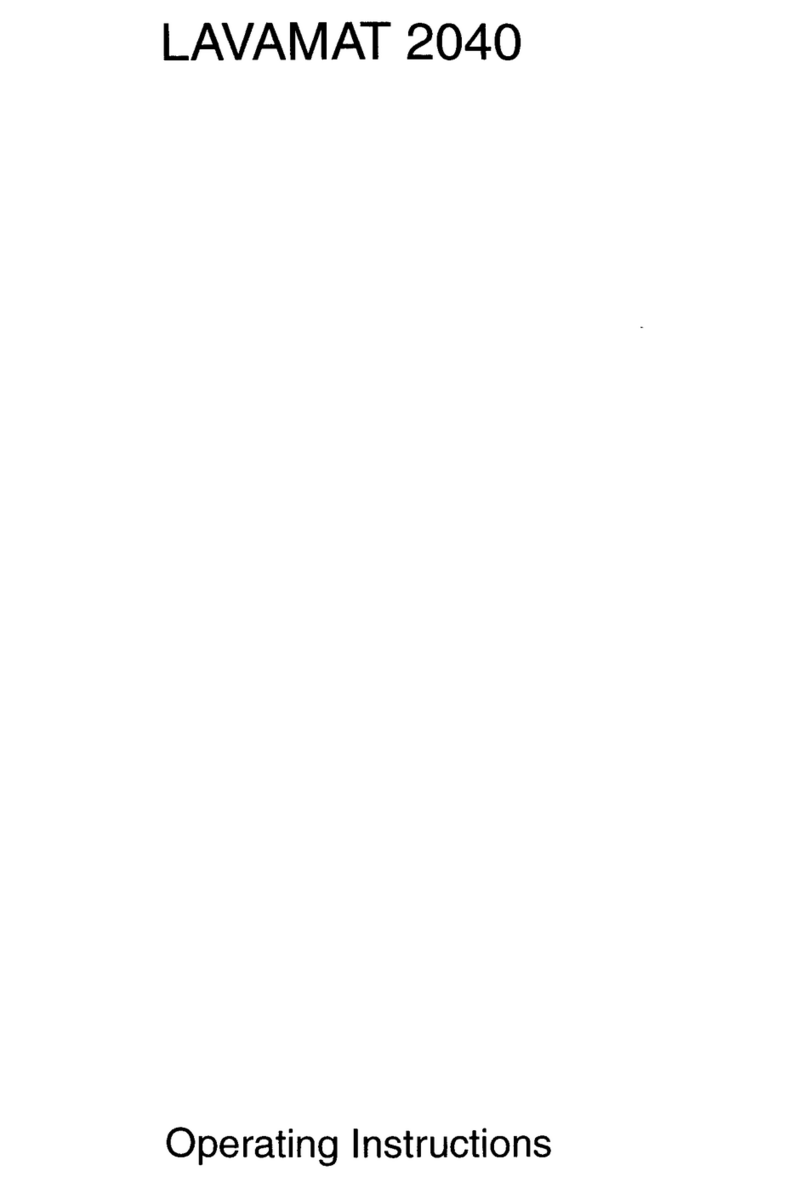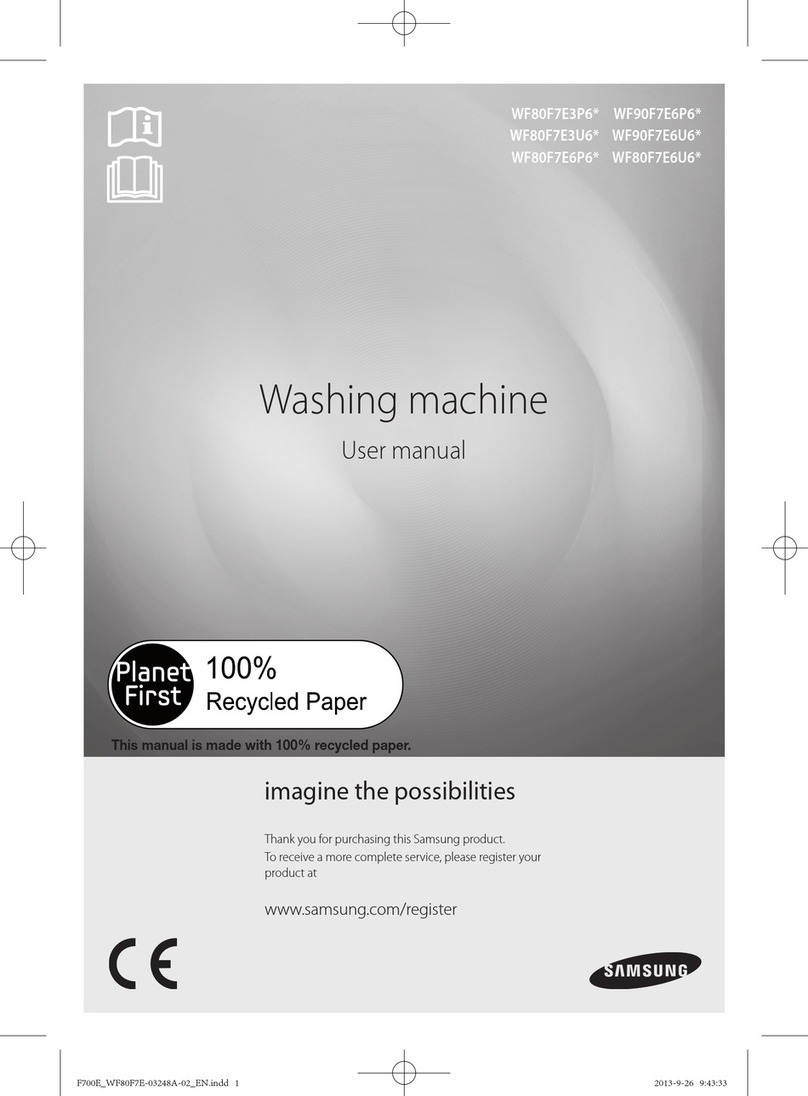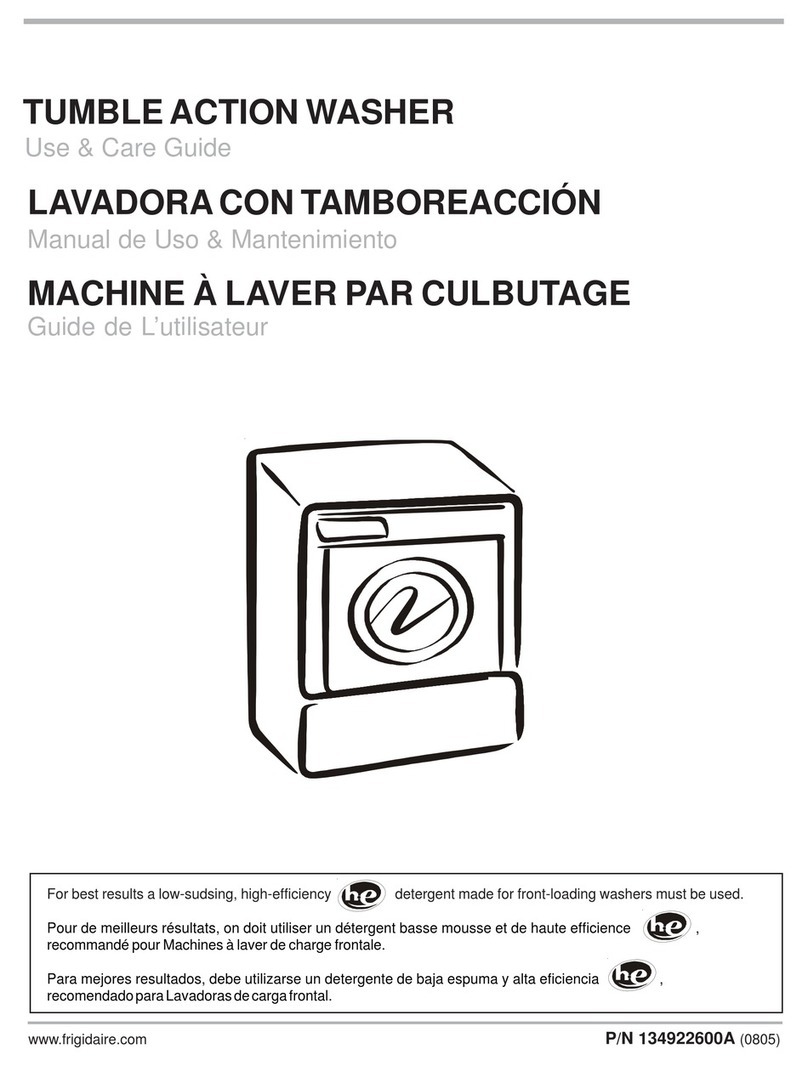IFB ELENA User manual

USE ONLY GENUINE IFB SPARES & ACCESSORIES
* Company shall not be responsible for defects arising due to usage of spurious parts and accessories
OPERATING MANUAL
Advancing the science of washing

1
ear Cstomer
Du
A warmwelc me to the interna ional family ofo t
IFB ‘tumble wash’ technology based w shing machine
a
owners.
our washing machine, is truly going t be your
Yo
freedommachin .Itrequiresj st30secondsofyourti e in
e u m
loadingthefabricsandsettingtheprogramme.
Thereafter, you are totally free to do what you please.
This washing machine does nt need your super ision
ov
anymor This washing machine s modelled on the u iquee i n
u
‘tumble wash’ concept for s per or fabric care and wash
i
performances.
As you read this manual you will understand what this
a
wshingmachinecandoforyou.
For any futher information, pla e conta t yor nearest
es c u
delearorIFB ServiceCentre.

CONTENTS
KNOW YOUR MACHINE 6
INSTALLATION 7
qPre Installation
qUnpacking
qSetting Up
qWater Inlet
qWater Outlet
qElectrical Connection
USING YOUR MACHINE 9
qControl Panel
qAutomatic Detergent Dispenser Tray
qSelector Buttons
qProgramme Selector Knob
qProgramme Selection
qProgramme Selection Chart
OPERATION 13
qSorting of Garments
qLoading the Machine
qDetergent to be used and Quantity
qTreatment of Stains
qWash Load Guide
qInternational Washing Symbols
qProgramme Run
qSwitching Off the Machine
qCheck Points
MAINTENANCE 19
qFluff Filters
qDrum
qSieves
qFrost Protection
qDraining During Emergencies
FAULT DIAGNOSIS 21
qWhy does it happen?
SAFETY PRECAUTIONS 22
TECHNICAL DATA 23
2

ADVANTAGES OF TUMBLE WASH
qMOST EFFECTIVE CLEANING AS THE CLOTHES PASS THROUGH
SOAPY WATER AND ALSO FALL ON SOAP SOLUTION IMPROVING
WETTING OF CLOTHES.
qRESEMBLES THE THUMPING AND RUBBING ACTION OF GENTLE
HAND WASH.
qUSES LESS WATER COMPARED TO TUB TYPE TOP LOADERS.
qLESS WATER MEANS LESS DETERGENT AND ELECTRICITY
CONSUMPTION.
qWASHING IS EFFECTIVE BY DETERGENCY, SOAKING, HEATING,
TUMBLING AND SQUEEZING.
qGIVES BETTER DRYING EFFECT BY SPINNING.
ADVANTAGES OF TUMBLE WASH
3
KNOW YOUR MACHINE

INSTALLATION
WATER INLET
DRAIN
PIPE
WATER INLET
DRAIN
PIPE
WATER
SUPPLY
STOP
LOCK
REDUCER
MACHINE
WATER
INLET
1/2 3/4
1. Make sure there is a 16 amp. 3-pin electrical point preferably with a 16 amp.
fuse, within 1 meter of the machine. Make sure it has proper earthing.
2. Fixed plumbing is recommended for
the machine. The water inlet of the
machine has a collar with3/4”parallel
internal threads. The water supply
point with an external 3/4” parallel
thread should be available within1
meter of the machine’s location.
4. Please inform our service centre for installation and demonstration of the
machine once the points mentioned above have been completed.
3. Two options on the water inlet and drain
pipe connection are shown. In case these
possibilities do not exist for the drain pipe,
please arrange an additional length of pipe.
PRE-INSTALLATION
1. Remove Carton.
2. Remove wooden base. Keep machine on floor
or trolley.
3. Place the machine at the site at which it is to be
installed.
4. Remove transit bolts.
5. Insert plastic caps provided into holes vacated and press till they click into
place.
6. Remove packing from the bottom of the motor
7. Keep transit bolts carefully. They will be required in case you need to shift the
machine again.
8. For shifting and re-installation at a new site,please get in touch with our service
personnel.
9. Keep packaging material carefully. It comes handy while shifting residence.
10. PLEASE DO NOT OPERATE THE MACHINE TILL TRANSIT BOLTS HAVE BEEN
REMOVED.
UNPACKING
4

1. MAKE SURE THAT THE MACHINE RESTS ON ALL
FOUR FEET ON A LEVEL SURFACE.Adjustable
screws are provided at the bottom to allow
levelling.
2. Loosen securing nut. Adjust the screw to change
level. Tighten securing nut to ensure that screw is
locked into place.
3. MACHINE SHOULD BE LEVELLED AGAIN IN C A S E
IT IS MOVED TO ANEW SITE.
1. A drain pump is provided in the machine to pump out
used water.
2. The end of the outlet should be placed near a drain. If
necessary, it can be placed over the edge of a sink
at a maximum height of 1 mt. from the floor level.
3. Allow free flow of water from the outlet pipe.
1. Check that the electrical line can take the required
load.
2. Connect to a 220V, 50 Hz single phase AC supply.
3. Machine must be earthed properly before
operation. This can be done by using a 3 pin plug
and properly earthed socket of 16 ampere rating.
4. Ensure that there is a firm connection between the 3
pin plug and socket, else it may result in sparking and
subsequent failure of 3 pin plug.
5. Use of extension cord not recommended.
SETTING UPSETTING UP
1. Connect inlet hose to water tap/line.
2. Do not connect machine to a hot water supply.
WATER INLETWATER INLET
WATER OUTLETWATER OUTLET
ELECTRICAL CONNECTIONELECTRICAL CONNECTION
16 AMPS
X
X
WATER INLET
DRAIN
PIPE
WATER INLET
DRAIN
PIPE
5

CONTROL PANEL
Let’s take a look at the control panel and understand the working of each of its features. Each feature
serves a specific purpose in the complete operation of the machine.
6

AUTOMATIC DETERGENT DISPENSER TRAY
Designed for automatic dispensing of
detergent. The Detergent Dispenser Tray
should be filled with detergent before the start
of a programme.
Normal-wash chamber: (Marked-I),to be filled
with - detergent during every wash
programme. Do not fill detergent in other
chambers.
The detergent tray must be pulled out, filled as
required and shut before the machine is
switched on.
SELECTOR BUTTONS
ON/OFF Button
qTo switch ON the machine press
button.
qTo switch OFF the machine release
button.
Heater On Button
qSwitches on the heater Temp.
0
selection 60 C
qTo be pressed when hot wash is
required.
7

PROGRAMME SELECTOR KNOB
qTo select the right programme as per the
fabric being washed and extent of soilage.
qA choice of 10 programmes is available to
wash different kinds/loads of clothes.
qProgramme selection should be done before
the machine is switched ON.
qTHE STARTING POINT OF PROGRAMME NEEDS TO BE SELECTED BY
SHIFTING THE PROGRAMME SELECTOR KNOB ADJACENT TO
PRINTED LETTERS. OPERATING THE MACHINE BEYOND PRINTING
ZONE MAY RESULT IN HIGHER CONSUMPTION OF WATER &
ELECTRICITY AND WILL NOT IMPROVE WASH QUALITY.
qAfter initiating the programme, machine runs through automatically. If
for any reason you wish to change the programme switch OFF the
machine , then set the desired programme and re-start.
qKNOB SHOULD BE TURNED ONLY IN CLOCKWISE DIRECTION.
PROGRAMME SELECTION
1. COTTONS
To be used for whites and coloureds of cotton or predominantly of cotton
in case of mixed load.
STAGE I: Main wash - Heavy wash / Normal wash / Quick wash
qClothes are soaked, tumbled in hot water with detergent for longer
duration to remove dirt. During draining dirty water, it is cooled down
by adding cold water. Clothes are tumbled to expose more surface,
squeezed by spinning to remove dirt inside the fabric.
qIF CLOTHES ARE NOT VERY DIRTY, THE MAIN WASH CAN BE
STARTED BY DIRECTLY SETTING THE PROGRAMME SELECTOR
KNOB AT NORMAL OR QUICK WASH TO REDUCE WASHING TIME.
8

STAGE II : Rinse
qAfter washing, the rinsing is done automatically four times to remove
traces of detergent and dirt from clothes.
qFor most efficient rinsing two intermittent short spins are provided.
STAGE III : Intense spin Dry
qSpin drying takes place at 600 rpm for longer duration.
2.Easy Care Programme
To be used for easy care fabrics like polyester blends or
predominantly having such fabric in mixed load.
STAGE 1 : Main Wash : synthetic / delicates
qClothes are soaked, tumbled in hot water with detergent for lesser
duration than main wash of Normal wash programme. During
draining of dirty water, it is cooled down by adding cold water.
Clothes are tumbled to expose more surface, squeezed by spinning
to remove dirt.
STAGE II : Rinse
qAfter washing the rinsing is done automatically three times to remove
traces of detergent and dirt from clothes.
STAGE III : Short spin Dry
Spin drying takes place at 600 r.p.m for shorter duration.
Exclusive spin drying programmes : Intense spin Dry / Short spin Dry
qCan be used for spin drying hand washed/wet clothes.
qTurn programme selector knob directly to the spin drying points
after loading the clothes.
qSwitch ON the machine.
Note:
IN CASE ELECTRICITY / WATER SUPPLY GOES OFF, THE
MACHINE STOPS AND STARTS AGAIN FROM THE SAME POINT,
AUTOMATICALLY, ON RESUMPTION OF ELECTRICITY/ WATER
SUPPLY.
9

OPERATION
SORTING OF GARMENTS
qMachine to be used for machine washable fabrics only (Look for
wash symbols given on your garments.)
qNon-fast coloured should be washed with like colours only .Wash
whites separately from colours.
qCheck the pockets for any loose articles like coins, keys, keychains
etc. Remove these articles as these can damage the drum/tub.
qDo not mix clothes that give lint with clothes that attract lint (e.g lint
givers-woollens, socks, coarse cotton fabrics etc. Lint takers-
synthetic fibres and corduroys).
LOADING THE MACHINE
qOpen the front porthole door, place
garments loosely inside drum. For best
results load garments one by one
,preferably mix of large and small
clothes
qTurn knitted garments inside out,
remove loose hooks, rings and pins
found on curtains etc.
Or
Tie a knot around them with the
garment itself.
qClose door and press till you hear a
click. Ensure that no cloth is jammed
between door and rubber gasket of
frame.
qFor large garments like bed covers and
curtains etc. open out the garments and
hold from the centre to load.
qEnsure that volume of load allows the clothes to tumble freely in the
drum for best wash results.
qOver loading the drum will affect wash quality. It can also damage
the machine and clothes in the long run.
qRunning the machine under loaded may cause excessive vibration,
noise and damage.
10

I
11

DETERGENT TO BE USED AND QUANTITY
qThe best results will be achieved using correct amount of washing
machine detergent.
qApproximate quantities to be used:
Full load i.e. 5 kgs Detergents to be used as per directions
indicated by the manufacturer on their
package.
Half Load
i.e. 2.5 kg and below Use 20 to 25% less detergent.
qLiquid detergents can be used.
qHard water and heavily soiled clothes require more than the
recommended quantity of detergents.
qFrequent use of insufficient detergent will be noticeable as follows:
- Washing appears grey or not properly clean
- Grey - brown stains form on the washing
qExcess use of detergent will result in
- Higher environment pollution
- Generation of too much foam
- Scale builds up
TREATMENT OF STAINS
qStains need to be treated immediately when they are fresh. Usually stains
are categorised as absorbed stains, built-up stains, and compound stains.
qAbsorbed stains can be removed by rubbing gently a pad containing a
suitable solvent over the stain from outer edge towards centre by
keeping stained cloth on absorbent fabric.
qBuilt up and compound stains may be removed by first carefully
brushing off stained area. Then rub gently with a pad containing solvent
from the back of fabric.
qIt is advisable to try out the solvent on hidden part of the garment to verify
its effect on cloth.
12

13

14

PROGRAMME RUN
Note:
qDuring the programme run the knob turns automatically in the clockwise
direction only.
qWashing, rinsing and spinning can be seen through the porthole window.
qAt any moment the position of the knob with respect to its start position
shows how far the programme has advanced.
SWITCHING OFF THE MACHINE
qThe wash programme automatically completes at the End.
qTo switch the machine OFF push in the programme selector knob
qPorthole door can be opened only after 90 seconds
qRemove clothes from inside the machine
qLeave door slightly ajar to dry out the inside of the machine
CHECK POINTS
Before switching your machine ‘ON’check...
qThe machine is connected to a 220V, 50 Hz supply with proper earthing.
qThe water inlet stopcock is fully open.
qThe hoses are not bent or twisted.
qDry clothes are loaded into the machine drum, and door is closed firmly
with a click.
qThe required amount of detergent is filled in the compartment.
qAfter completing the above check points the machine should be switched
ON by gently pulling out the programme selector knob.
qThe programme Selector knob is turned to the appropriate programme
position in a clockwise direction only.
qThe Fluff Filter is not open.
15

ENSURE THAT THE FLUFF FILTER IS
NOT BLOCKED, CLEAN WEEKLY OR
AS OFTEN AS REQUIRED.
BEFORE USING MACHINE AGAIN
RUN THE MACHINE WITHOUT
CLOTHES AND DETERGENTS BY
SELECTING ANY SHORT WASH
PROGRAMME. THIS WILL ENSURE
THAT THE FLUFF FILTER LINE GETS
FILLED WITH WATER.
ALTERNATIVELY POUR TWO MUGS
OF WATER (APPROX, 1.5 LTRS.)
DIRECTLY INTO THE DRUM.
DO NOT OPEN THE FLUFF FILTER
DURING A PROGRAMME RUN.
MAINTENANCE
FLUFF FILTER
Open door flap by pressing on the right hand. Clean filter under running water
Place shallow container under the tray to
collect water that comes out.
Replace filter and screw on tightly
to avoid leakage of water
Turn Fluff Filter cover anti-clockwise
drain water into container and
take out filter
3
2 5
1 4
16

DRUM
Rust Stains
Never leave metal items e.g. paper clips, safety pins etc. in
the drum as there is a danger of rusting. If there are any rust
stains remove with a non-chlorine agent. Special non-metal
sponges (never use steel wool) may also be used.
SIEVES
Cleaning of Water Connection Sieves, filter
1. Turn off Taps. Disconnect Power supply to the machine.
Unscrew inlet hose from machine as well as from the tap
and drain out water from the hose.
2. Pull the sieve out of the magnetic valve with a pair of flat
nosed pliers and clean under running water with a brush.
Fit Sieve back to the valve.
3. Remove the filter mesh from the tap end of the inlet hose
and clean under running water with a brush.
4. Fit the filter mesh back to inlet hose.
5. Screw inlet hose back to the machine and the tap. Ensure
that both the sieves and filter are in place.
6. Turn on the tap.
Cleaning of Porthole Door Area:
qAfter every wash clean vapour off porthole door.
qLift the fold in the rubber gasket under porthole
periodically to remove lint and dirt preferably after every
wash.
FROST PROTECTION
If the machine is being operated in very cold temperature, all the water
should be drained out after use.
qRemove Fluff Filter.
qLocate the drain hose and drain the water.
qDisconnect inlet hose from the tap and drain.
DRAINING DURING EMERGENCIES
In case of a long power failure during a programme run, the water
can be drained from the drum through the drain hose
qAllow the water in the machine to cool down sufficiently.
qLocate the drain hose and pull out the drain hose to drain water in a large
shallow container.
qBefore restarting machine, ensure that drain plug is fixed on drain hose
properly and fluff filter water line is filled with water by running the
machine without any clothes or detergents.
qSpillage of water can rust the base plate. Draining through drain
hose prevents rusting.
17

FAULT DIAGNOSIS
WHY DOES IT HAPPEN?
WATER DOES NOT ENTER MACHINE/DETERGENT NOT
BEING FLUSHED INTO DRUM.
qCheck water supply
qPorthole door not firmly closed
qWater tap not turned on
qBent inlet hose
qSieve on inlet valve clogged
SUDS ESCAPING FROM DETERGENT DISPENSER TRAY.
qDetergent used is not a washing machine detergent
qExcessive detergent used
WATER LEAKAGE FROM THE MACHINE.
qInlet/Outlet hose connection loose
qFluff Filter not screwed on properly
qInlet hose leaking
qDrain plug not fixed properly onto Drain hose.
MACHINE DOES NOT DRAIN.
qFluff Filter clogged
qOutlet hose end above 1 mtr. from floor level
MACHINE VIBRATES STRONGLY DURING SPINNING.
qMachine not levelled properly
qClothes not loaded as instructed
qWater not drained completely
MACHINE DOES NOT START.
qCheck position of programme selector knob
qCheck water supply
qPorthole door not closed properly
MOTOR NOISE
qIt is normal for noises to be heard while motor is running. However
wash load, belt tension and motor mounting bolt should be
checked for specified limits.
PUMP NOISE
qIt is normal for noises to be heard from the pump during the start-up
and final stage of draining. However check for fluff filter clogging.
18

SAFETY PRECAUTIONS
1. Ensure that the machine is properly balanced on four adjustable feet.
2. Ensure that the machine is connected to 3 pin socket with earth and 16
amps fuse.
3. The machine is tested with water during assembly for performance
checking. Condensed droplets of water may remain inside the drum. It is
0
advisable to run the machine without wash load at 60 C with detergent
for the first time after installation.
4. The programme knob should be turned clockwise only.
5. Programme selection must be done prior to switching on the machine. For
resetting of programme, switch off the machine, select the programme and
re-start. Do not operate the machine beyond the printed zone.
6. Servicing should be handled by the Company’s authorized personnel
only.
7. Check for the end of the programme before opening porthole door. The
door can be opened about 90 seconds after the wash cycle is over or
machine is switched off. This is a safety feature. The door should not be
forced open.
8. Check label on garments for determining conditions under which fabrics
are to be washed.
9. Use detergent recommended for washing machine.
10. Ensure that the electrical line on which the machine is used can take the
required load.
11. Check the inside of drum before loading the clothes.
12. Protect the machine from direct sunlight and do not splash water on
it. Clean with a damp cloth.
13. Keep your machine dry to avoid corrosion / rusting. Take special care to
wipe the machine after cleaning the fluff filter.
14. The machine should ideally be installed on the floor, It can be installed on
any suitable platform or trolley, if desired by the customer.
15. Clean the shell lower and detergent tray periodically by taking out the
detergent tray.
16. Incase of plastic table top, don’t use the table top as an ironing board.
19
Other manuals for ELENA
1
This manual suits for next models
1
Table of contents
Other IFB Washer manuals
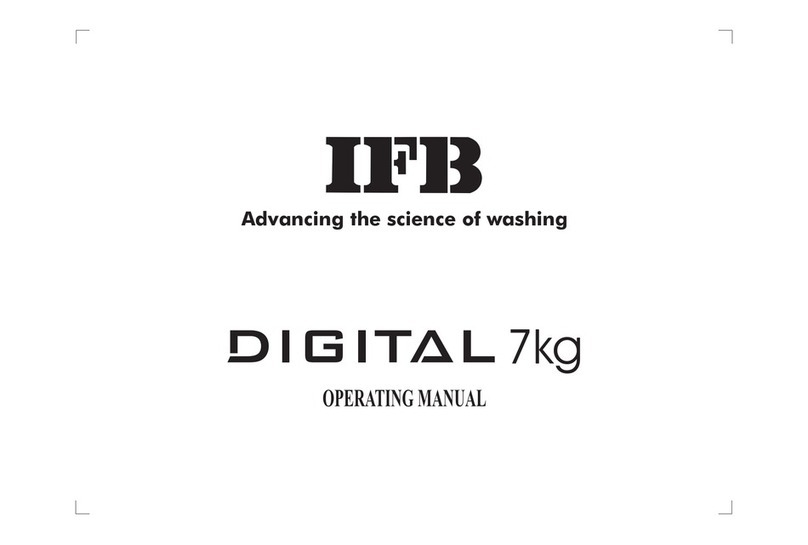
IFB
IFB Digital User manual

IFB
IFB Digital User manual

IFB
IFB Diva User manual
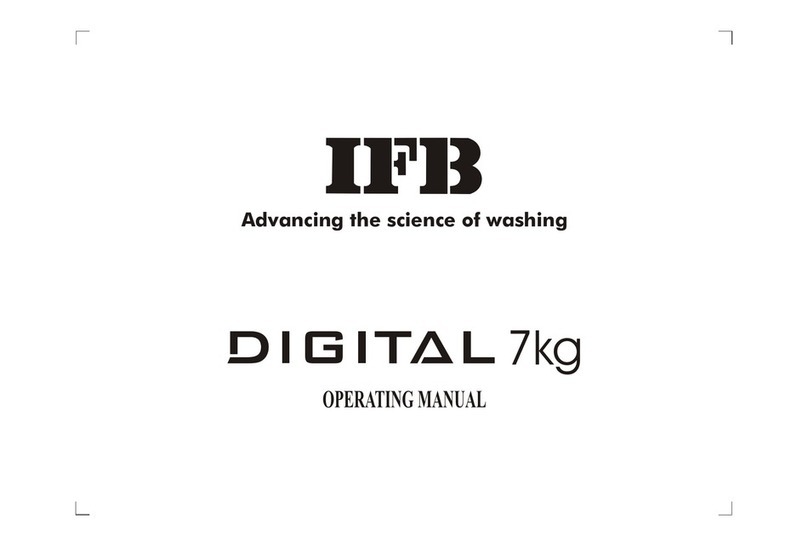
IFB
IFB WASHER 9KG DRYER 7KG User manual
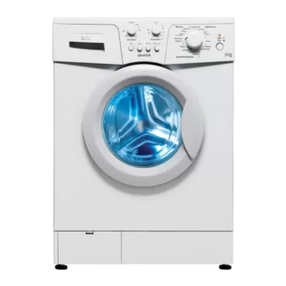
IFB
IFB Senator User manual
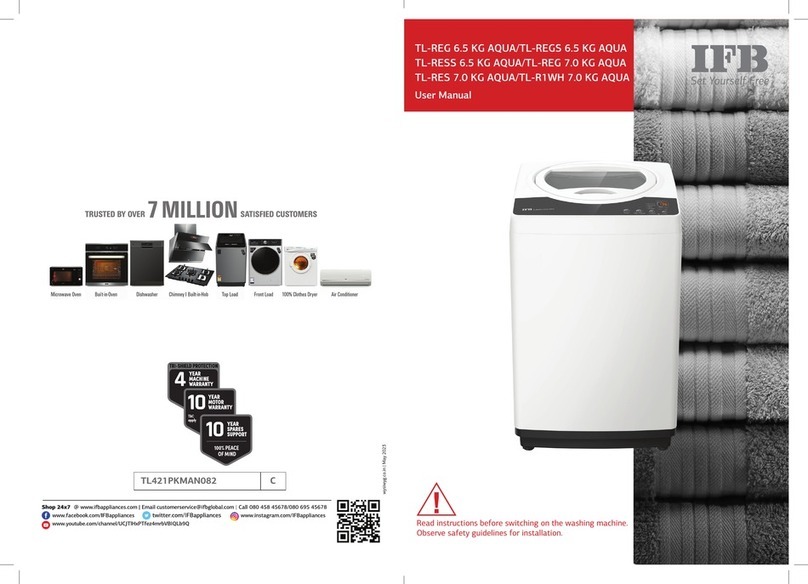
IFB
IFB TL-REG 6.5 KG AQUA User manual

IFB
IFB Senorita Dx User manual

IFB
IFB AW6501SB User manual
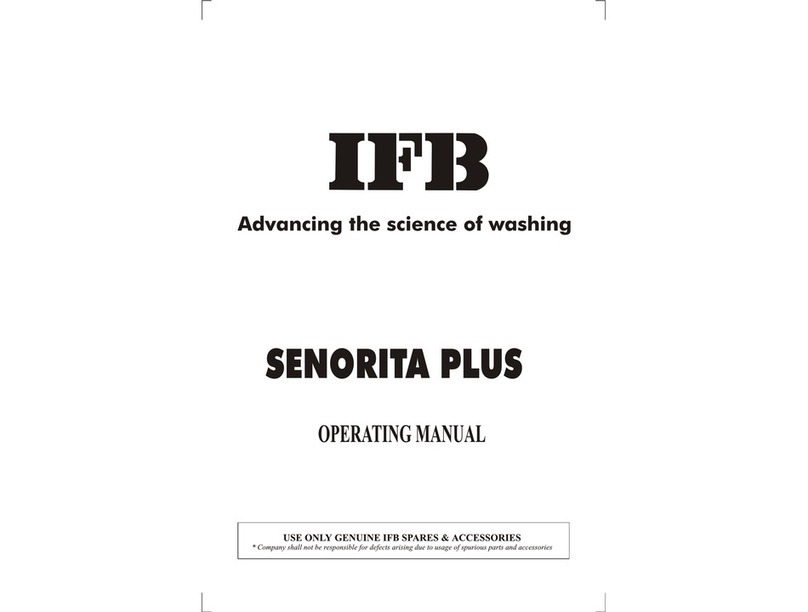
IFB
IFB SENORITA PLUS User manual
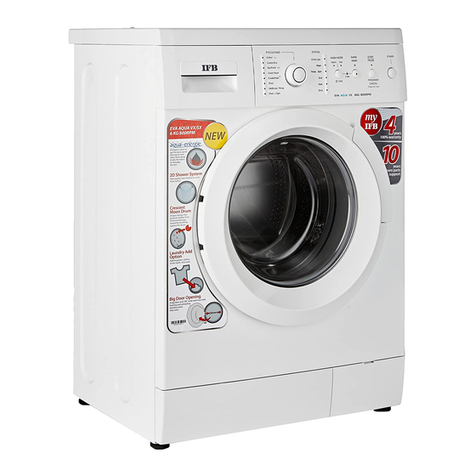
IFB
IFB EVA-VX 5.5; Elena Aqua SX 6.0 User manual
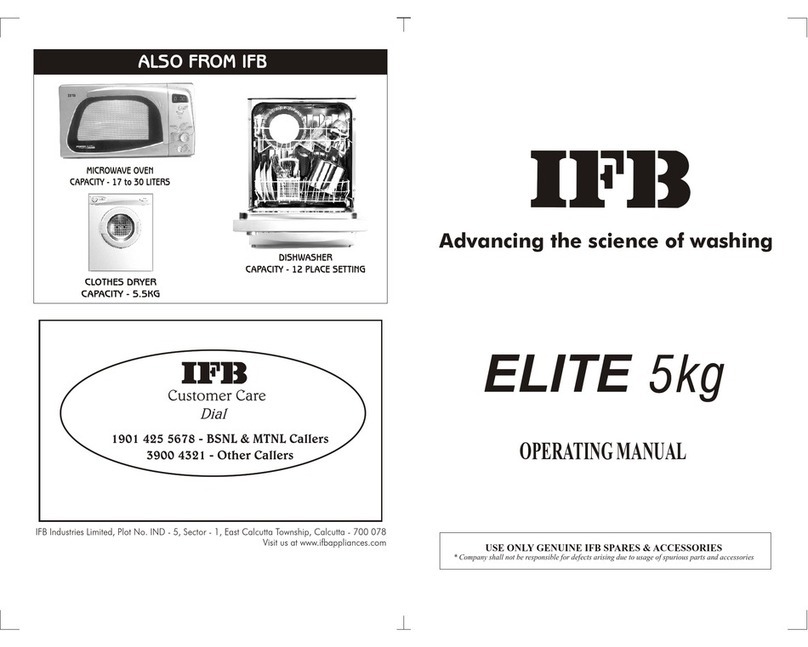
IFB
IFB Elite 5 Kg User manual
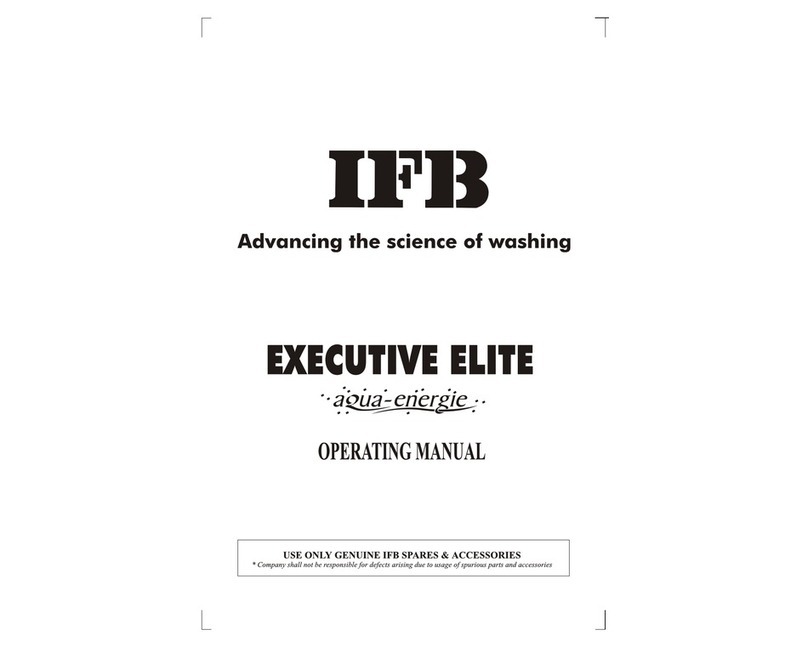
IFB
IFB Executive Elite User manual
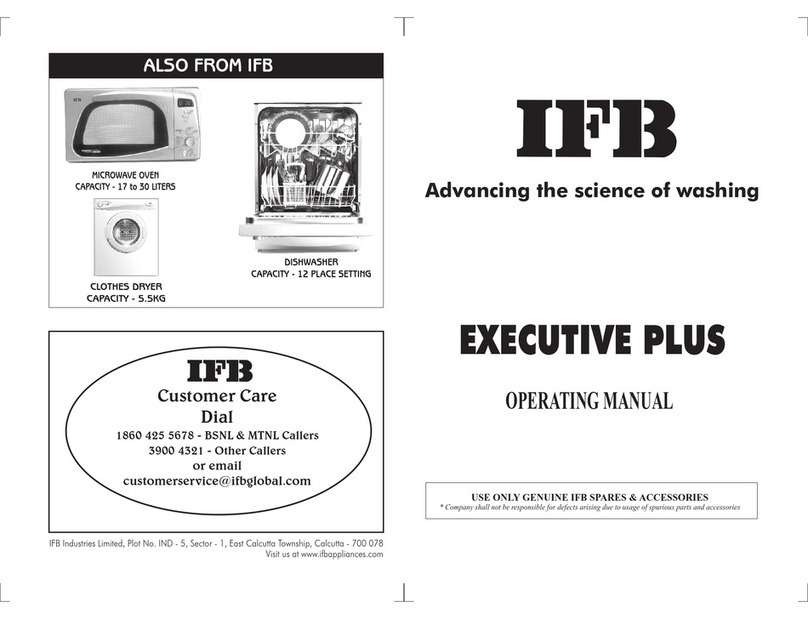
IFB
IFB EXECUTIVE PLUS WTEX+B User manual
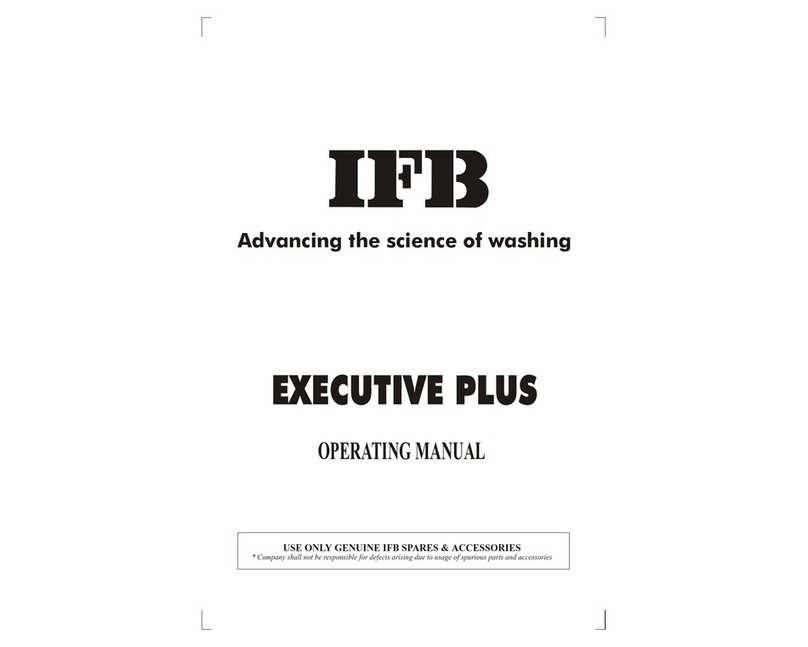
IFB
IFB Executive Plus User manual

IFB
IFB Diva User manual
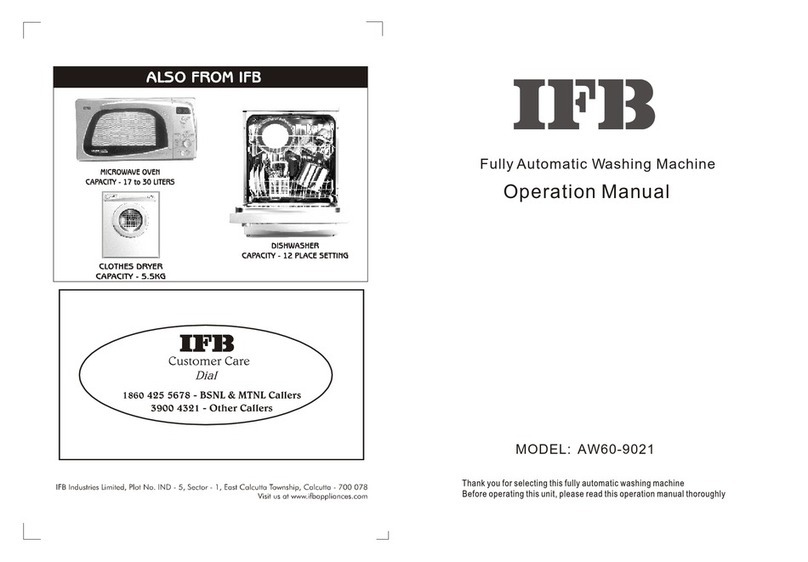
IFB
IFB AW60-90210 User manual

IFB
IFB AW60-806 User manual

IFB
IFB Eva VX 700RPM User manual
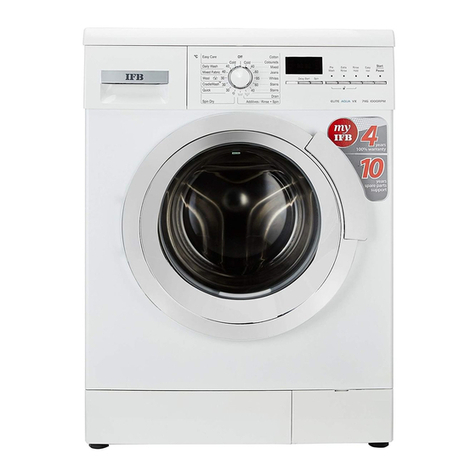
IFB
IFB Elite SX Series User manual

IFB
IFB Digital User manual




